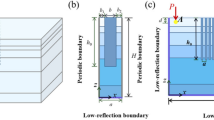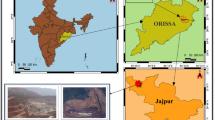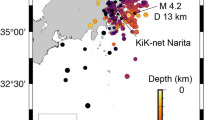Abstract
Past researchers have anticipated the occurrence of a great earthquake in the central Himalayas in the near future. This may cause serious damage in the Kathmandu Valley, which sits on an ancient lake bed zone, with lacustrine sediments of more than 500 m depth. In this study, the predominant frequency of ground motion is evaluated using the Horizontal-to-Vertical (H/V) spectral ratio technique and recordings of ambient noise. The results of the H/V ratio show two peaks in about 20 percent of the locations, which are distributed mainly in and around the center and northern part of the Kathmandu Valley. The predominant frequencies vary from 0.5 Hz to 8.9 Hz in the study area, whereas the second resonance frequency varies from 4 Hz to 6 Hz in the center and northern part of the valley. This indicates that the center and northern part of the valley have a wide range of resonance frequency due to two levels of impedance contrast — one may be from the surface layer and the other may be from the layer underneath. These two levels of resonance indicate the importance of considering the effects of surface and lower layers during the planning and designing of infrastructures in the Kathmandu Valley.
Similar content being viewed by others
References
Ambraseys N and Douglas J (2004), “Magnitude Calibration of North Indian Earthquakes,” Geophysical Journal International, 159(1): 165–206.
Bilham R, Bodin P and Jackson M (1995), “Entertaining a Great Earthquake in Western Nepal: Historic Inactivity and Geodetic Tests for the Present State of Strain,” Journal of Nepal Geological Society, 11: 73–78.
Bonnefoy-Claudet S, Cotton F and Bard PY (2006a), “The Nature of Noise Wavefield and Its Applications for Site Effects Studies: A Literature Review,” Earth-Science Reviews, 79: 205–227.
Bonnefoy-Claudet S, Cornou C, Bard PY, Cotton F, Moczo P, Kristek J and Fäh D (2006b), “H/V Ratio: a Tool for Site Effects Evaluation Results from 1-D noise Simulations,” Geophysical Journal International, 167: 827–837.
Chitrakar GR and Pandey MR (1986), “Historical Earthquakes of Nepal,” Bulletin Geological Society of Nepal, 4:7–8.
Dahal RK and Aryal A (2002), “Geotechnical Properties of Soil of Sundhara and Jamal Area of Kathmandu,” Journal of Nepal Geological Society, 27(Special Issue):77–86.
D’Amico V, Picozzi M, Albarello D, Naso G and Tropenscovino S (2004), “Quick Estimates of Soft Sediment Thicknesses from Ambient Noise Horizontal to Vertical Spectral Ratios: a Case Study in Southern Italy,” Journal of Earthquake Engineering, 8(6): 895–908.
Delgado J, Casado CL, Lopez Giner J, Estevez A, Cuenca A and Molina S (2000), “Microtremors as a Geophysical Exploration Tool: Applications and Limitations,” Journal of Pure and Applied Geophysics, 157:1445–1462.
Dinesh BV, Nair GJ, Prasad AGV, Nakkeeran PV and Radhakrishna MC (2010), “Estimation of Sedimentary Layers Shear Wave Velocity Using Micro-tremor H/V Ratio Measurements for Bangalore City,” Soil Dynamics and Earthquake Engineering, 30:1377–1382.
Dixit A, Dwelly-Samant L, Nakarmi M, Pradhanang S and Tucker B (1998), “The Kathmandu valley Earthquake management plan,” Published by National Society for Earthquake Technology-Nepal, pp. 38. http://www.preventionweb.net/english/professional/publications/v.php?id=1496.
Dongol GMS (1985), “Geology of the Kathmandu Fluvio-Lacustrine Sediments in the Light of New Vertebrate Fossil Occurrences,” Journal of Nepal Geological Society, 3: 43–47.
Fäh D, Suhadolc P, Mueller St and Panza GF (1994), “A Hybrid Method for the Estimation of Ground Motion in Sedimentary Basins: Quantitative Modeling for Mexico City,” Bulletin of the Seismological Society of America, 84: 383–99.
Field EH, Clement AC, Jacob KH, Aharonian V, Hough SE, Friberg PA, Babaian TO, Karapetian SS, Hovanessian SM and Abramian HA (1995), “Earthquake Site-response Study in Giuari (Formerly Leninakan) Armenia Using Ambient Noise Observations,” Bulletin of the Seismological Society of America, 85(1): 349–353.
Field E and Jacob K (1993), “The Theoretical Response of Sedimentary Layers to Ambient Seismic Noise,” Geophysical Research Letters, 20(24): 2925–2928.
Fujii R and Sakai H (2002), “Paleoclimatic Changes During the Last 25 Myr Recorded in the Kathmandu Basin Central Nepal Himalayas,” Journal of Asian Earth Sciences, 20: 255–266.
Gosar A (2007), “Microtremor HVSR Study for Assessing Site Effects in the Bovec Basin (NW Slovenia) Related to 1998 M w 56 and 2004 M w 52 Earthquakes,” Engineering Geology, 91: 178–193.
Gosar A and Lenart A (2010), “Mapping the Thickness of Sediments in the Ljubljana Moor Basin (Slovenia) Using Microtremors,” Bulletin of Earthquake Engineering, 8: 501–518.
Gosar A and Martinec M (2009), “Microtremor HVSR Study of Site Effects in the Ilirska Bistrica Town Area (S Slovenia),” Journal of Earthquake Engineering, 13: 50–67.
Guéguen P, Chatelain JL, Guillier B and Yepes H (2000), “An Indication of the Soil Topmost Layer Response in Quito (Ecuador) Using Noise H/V Spectral Ratio,” Soil Dynamics and Earthquake Engineering, 19: 127–133.
Guéguen P, Chatelain J-L, Guillier B, Yepes H and Egred J (1998), “Site Effect and Damage Distribution in Pujili (Ecuador) after the 28 March Earthquake,” Soil Dynamics and Earthquake Engineering, 17: 329–334.
Guo X, Wong YL and Yuan YF (2002), “Estimation of Damping Ratio of Soil Sites Using Microtremor,” Earthquake Engineering and Engineering Vibration, 1(1): 45–49.
Hardesty K, Wolf LW and Bodin P (2010), “Case History, Noise to Signal: A Microtremor Study at Liquefaction Sites in the New Madrid Seismic Zone,” Geophysics, 75(3): 83–90.
Hough SE and Bilham R (2008), “Site Response of the Ganges Basin Inferred from Re-evaluated Macroseismic Observations from the 1897 Shillong 1905 Kangra and 1934 Nepal Earthquakes,” Journal of Earth System and Science, 117: 773–782.
Huang HC and Teng TL (1999), “An Evaluation on H/V Ratio vs Spectral Ratio for Site Response Estimation Using the 1994 Northridge Earthquake Sequence,” Pure and Applied Geophysics, 156: 631–649.
Ibs-von Seht M and Wohlenberg J (1999), “Microtremor Measurements Used to Map Thickness of Soft Sediments,” Bulletin of the Seismological Society of America, 89: 250–259.
JICA (2002), The Study on Earthquake Disaster Mitigation in the Kathmandu Valley Kingdom of Nepal, Japan International Cooperation Agency (JICA) and Ministry of Home Affairs His Majesty’s Government of Nepal, Volume I 2002, Summary p. 110, Volume III, Main Report 2/2, Earthquake Disaster Assessment and Data Base System, pp. 76.
Kanai K (1957), “The Requisite Conditions for Predominant Vibration of Ground,” Bulletin of Earthquake Research Institute, University of Tokyo, 31: 457.
Khattri KN (1987), “Great Earthquakes Seismicity Gaps and Potential for Earthquake Disaster along the Himalaya Plate Boundary,” Tectonophysics, 138: 79–92.
Kramer SL (1996), Geotechnical Earthquake Engineering, Chapter 7 and 8, Pearson Education Inc.
Lachet C, Bard PY, Hatzfeld D, Theodulidis N, Papaioannou C and Savvaidis A (1996), “Site Effects and Microzonation in the City of Thessaloniki (Greece) Comparison of Different Approaches,” Bulletin of the Seismological Society of America, 67: 713–724.
Langston CA, Chiu Shu-Chioung C, Lawrence Z, Bodin P and Horton S (2009), “Array Observations of Microseismic Noise and the Nature of H/V in the Mississippi Embayment,” Bulletin of the Seismological Society of America, 99(5): 2893–2911.
Lebrun B, Hatzfeld D and Bard PY (2001), “A Site Effect Study in Urban Area: Experimental Results in Grenoble (France),” Pure and Applied Geophysics, 158: 2543–2557.
Lermo J and Chávaz-García FJ (1993), “Site Effect Evaluation Using Spectral Ratios with Only One Station,” Bulletin of the Seismological Society of America, 83: 1574–1594.
Lermo J and Chávaz-García FJ (1994), “Are Microtremors Useful in Site Response Evaluation,” Bulletin of the Seismological Society of America, 84(5): 1350–1364.
Molnar P (1990), “A Review of the Seismicity and the Rates of Active Underthrusting and the Deformatation at the Himalaya,” Journal of Himalayan Geology, 1: 131–154.
Molnar P and Pandey MR (1989), “Rupture Zones of Great Earthquakes in the Himalayan Region,” Proc. Ind. Acad. Sci. (Earth. and Plan. Sci.), 98: 61–70.
Moribayashi S and Maruo Y (1980), “Basement Topography of the Kathmandu Valley Nepal-An Application of the Gravitational Method to the Survey of a Tectonic Basin in the Himalaya,” Journal of Japan Society of Engineering Geology, 21: 30–37.
Mucciarelli M (2011), “Ambient Noise Measurements Following the 2011 Christchurch Earthquake: Relationships with Previous Microzonation Studies, Liquefaction, and Nonlinearity,” Seismological Research Letters, 82(6): 919–926.
Mugnier JL, Huyghe P, Gajurel AP, Upreti BN and Jouanne F (2011), “Seismites in the Kathmandu Basin and Seismic Hazard in Central Himalaya,” Tectonophysics, 509(1–2): 33–49.
Nakamura Y (1989), “A Method for Dynamic Characteristics Estimation of Subsurface Using Microtremor on the Ground Surface,” Quarterly Report of the Railway Technical Research Institute, 30(1): 25–33.
Özalaybey S, Zor E, Ergintav S and Tapırdamaz MC (2011), “Investigation of 3-D Basin Structures in the □zmit Bay Area (Turkey) by Single-station Microtremor and Gravimetric Methods,” Geophysical Journal International, 186: 883–894.
Pandey MR and Molnar P (1988), “The Distribution of Intensity of the Bihar-Nepal Earthquake 15 January 1934 and Bounds of the Extent of the Rupture Zone,” Journal of Nepal Geological Society, 5: 22–44.
Pandey MR, Tandukar RP, Avouac JP, Lavé J and Massot JP (1995), “Interseismic Strain Accumulation on the Himalayan Crustal Ramp (Nepal),” Geophysical Research Letters, 22(7): 751–754.
Pandey MR, Tandukar RP, Avouac JP, Vergne J and Héritier Th (1999), “Seismotectonics of the Nepal Himalaya from a Local Seismic Network,” Journal of Asian Earth Sciences, 17: 703–712.
Parolai S, Bormann P and Milkereit C (2002), “New Relationship between Vs Thickness of Sediments and Resonance Frequency Calculated by the H/V Ratio of Seismic Noise for the Cologne Area (Germany),” Bulletin of the Seismological Society of America, 92(6): 2521–2527.
Parolai S, Richwalski SM, Milkereit C and Bormann P (2004), “Assessment of the Stability of H/V Spectral Ratios from Ambient Noise and Comparison with Earthquake Data in the Cologne Area (Germany),” Tectonophysics, 390: 57–73.
Rana BJB (1935), Nepal Ko Maha Bhukampa (Great Earthquake of Nepal), Jorganesh Press.
Sakai H (2001), “Stratigraphic Division and Sedimentary Facies of the Kathmandu Basin Group, Central Nepal,” Journal of Nepal Geological Society, 25(Special Issue): 19–32.
Sakai H, Fujii R, Kuwahara Y, Upreti BN and Shrestha SD (2001), “Core Drilling of the Basin-fill Sediments in the Kathmandu Valley for Paleoclimatic Study: Preliminary Results,” Journal of Nepal Geological Society, 25(Special Issue): 9–18.
Sánchez-Sesma FJ, Rodríguez M, Iturrarán-Viveros U, Luzón F, Campillo M, Margerin L, García-Jerez A, Suarez M, Santoyo MA and Rodríguez-Castellanos A (2011), “A Theory for Microtremor H/V Spectral Ratio: Application for a Layered Medium,” Geophysical Journal International, 186: 221–225.
Seeber L and Armbruster J (1981), “Great Detachment Earthquakes along the Himalaya Arc and Long Term Forecasts” DW Simpson and PG Richards (Eds), Earthquake Prediction: An International Review, Maurice Ewing Series, American Gephysical Union Washington D C, 4: 259–277.
SESAME (2004), Guidelines for the Implementation of the h/v Spectral Ratio Technique on Ambient Vibrations Measurements Processing and Interpretation, SESAME European Research Project, Wp12 -Deliverable d2312 European Commission — Research General Directorate, Project No. EVG1-CT-2000-00026.
Sukumaran P, Parvez IA, Sant DA, Rangarajan G and Krishnan K (2011), “Profiling of Late Tertiary-Early Quaternary Surface in the Lower Reaches of Narmada Valley Using Microtremors,” Journal of Asian Earth Sciences, 41: 325–334.
Teves-Costa P, Oliveira CS and Senos ML (2007), “Effects of Local Site and Building Parameters on Damage Distribution in Angra do Heroísmo—Azores,” Soil Dynamics and Earthquake Engineering, 27: 986–999.
Theodulidis N, Panou AA, Hatzidimitriou P, Stylianidis K and Papazachos CB (2005), “Ambient Noise Horizontal-to-vertical Spectral Ratio in Site Effects Estimation and Correlation with Seismic Damage Distribution in Urban Environment: the Case of the City of Thessaloniki (Northern Greece),” Soil Dynamics and Earthquake Engineering, 25: 261–274.
Toshinawa T, Taber JJ and Berril JB (1997), “Distribution of ground Motion Intensity Inferred from Quationnaire Survey Earthquake Recordings and Microtremors Measurements-a Case Study in Christchurch New Zealand During the Arthurs Pass Earthquake,” Bulletin of seismological Society of America, 87: 356–369.
Tuan TT, Scherbaum F and Malischewsky PG (2011), “On the Relationship of Peaks and Troughs of the Ellipticity (H/V) of Rayleigh Waves and the Transmission Response of Single Layer over Halfspace Models,” Geophysical Journal International, 184: 793–800.
Walling MY, Mohanty WK, Nath SK, Mitra S and John A (2009), “Microtremor Survey in Talchir India to Ascertain Its Basin Characteristics in Terms of Predominant Frequency by Nakamura’s Ratio Technique,” Engineering Geology, 106: 123–132.
Wen RZ, Ren YF and Shi DC (2011), “Improved HVSR Site Classification Method for Free-field Strong Motion Stations Validated with Wenchuan Aftershock Recordings,” Earthquake Engineering and Engineering Vibration, 10: 325–337.
Woolery EW, Street R, and Hart P (2009), “Evaluation of Linear Site Response Methods for Estimating Higher-Frequency (>2Hz) Ground Motions in the Lower Wabash River Valley of the Central United States,” Seismological Research Letter, 80: 525–538.
Yeats RS and Lillie RJ (1991), “Contemporary Tectonics of the Himalayan Frontal Fault System: Folds Blind Thrusts and the 1905 Kangra Earthquake,” Journal of Structural Geology, 13: 215–225.
Yeats RS, Nakata T, Farah A, Fort M, Mirza MA, Pandey MR and Stein RS (1992), “The Himalayan Frontal Fault Sytem,” Annales Tectonicae, 6(Special Issue): 85–98.
Yoshida M and Igarashi Y (1984), “Neogene to Quaternary lacustrine sediemnts in the Kathamandu Valley, Nepal,” Journal of Nepal Geological Society, 4: 73–100.
Zandieh A and Pezeshk S (2011), “A Study of Horizontalto-Vertical Component Spectral Ratio in the New Madrid Seismic Zone,” Bulletin of the Seismological Society of America, 101(1): 287–296.
Author information
Authors and Affiliations
Corresponding author
Rights and permissions
About this article
Cite this article
Paudyal, Y.R., Yatabe, R., Bhandary, N.P. et al. A study of local amplification effect of soil layers on ground motion in the Kathmandu Valley using microtremor analysis. Earthq. Eng. Eng. Vib. 11, 257–268 (2012). https://doi.org/10.1007/s11803-012-0115-3
Received:
Accepted:
Published:
Issue Date:
DOI: https://doi.org/10.1007/s11803-012-0115-3




